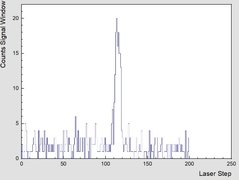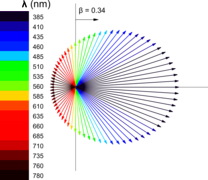Laser Spectroscopy
Lasers are applied in the atomic physics group at GSI for a wide range of fundamental research. The combination with the accelerator structure at GSI provides many possibilities for unique and ground-breaking experiments. They are used, e.g., for testing fundamental symmetries, for the determination of ground state properties of stable and exotic nuclei, and for the investigation of the atomic structure of Actinides and super heavy elements. Moreover, laser forces are also used to manipulate and even to cool down stored ions in the experimental storage ring ESR. The following list provides links to different laser spectroscopic experiments, which are performed at GSI. Many of these investigations are related to projects that are planned for the FAIR facility. In order to support laser spectroscopy experiments, GSI can provide modern laser equipment, pulsed lasers like Nd-YAG and tuneable dye lasers, continuous wave (cw) pump lasers as well as tuneable single-frequency lasers. Even a modern frequency comb based on femtosecond fibre laser systems is available.
Laser spectroscopy on highly charged ions
First time ever measured hyperfine splitting in hydrogen-like 208Bi82+
(GSI Helmholtzzentrum für Schwerionenforschung,Technische Universität Darmstadt, Westfälische Wilhelms Universität Münster, Physikalisch-Technische Bundesanstalt, Johannes Gutenberg-Universität, Argonne National Laboratory, TRIUMF Canada, The University of Edinburg, Imperial College London)
Resonance
In our recent beamtime at the GSI, in May 2022, we succeeded to produce and separate a sufficient amount of 208Bi82+, about 6×105 ions, to observe for the first time a laser resonance signal of an accelerator-produced isotope in a storage ring [Horst, 2023].
The experimental observation of this hyperfine line is an important step towards the determination of the specific difference of 208Bi, which can provide one of the most significant tests of strong-field bound-state QED in the magnetic sector.
The specific difference
The measurement of the so-called specific difference, Δ’E, between the hyperfine structures in hydrogen-like 209Bi82+ and lithium-like 209Bi80+ is supposed to be the most significant QED test in the magnetic sector of strong-field QED [Shabaev, 2001]. Our most recent measurement (Ullmann, 2017) showed a large deviation (> 7σ) from the theoretical prediction [Volotka, 2012], but a new determination of the nuclear magnetic moment in 209Bi resolved this puzzle and brought the theoretical prediction in agreement with experiment [Skripnikov, 2018]. The specific difference is calculated and measured in order to remove the influence of the nuclear magnetic moment distribution (Bohr-Weisskopf effect) onto the hyperfine structure splitting. Taking the difference of two electronic systems (H-like and Li-like) with the same nucleus is expected to cancel. To test this cancelation experimentally, it was proposed to extend these kind of hyperfine studies to the radioactive isotope of 208Bi.

SpecTrap – Spectroscopy Trap
(Technische Universität Darmstadt, Johannes Gutenberg-Universität Mainz, GSI Helmholtzzentrum für Schwerionenforschung, Westfälische Wilhelms Universität Münster, Imperial College London)
SpecTrap is a cryogenic Penning trap setup designed to capture and store highly-charged ions extracted from an EBIT or from any other external source. The cryogenic surrounding allows for efficient cooling of the ions during storage, thus opening the possibility for precision experiments with ions nearly at rest. Its optical accessibility furthermore allows laser cooling, laser excitation and optical observation, making it an ideal tool for precision spectroscopy of highly charged ions. At GSI, SPECTRAP is presently under commission. The final goal is precision laser spectroscopy experiments with highly-charged ions, which will be delivered by the HITRAP facility. For more information, click here.

Tests of fundamental symmetries
SRT – Special Relativity Test
(Johannes Gutenberg-Universität Mainz, Max-Planck-Institut für Kernphysik, GSI Helmholtzzentrum für Schwerionenforschung, Helmholtz-Institut Mainz, University of Manitoba, Max-Planck-Institut für Quantenoptik, Technische Universität Darmstadt)
The core of special relativity (SR) as a theory of local space-time is Lorentz invariance, which is one of the most fundamental symmetries that guide the construction of all quantum field theories. Additionally, general relativity contains SR as a limiting case. Because of this fundamental role there is much interest in experimental tests of SR. One of the pillars of SRT-tests is time dilation, which can be measured via the optical Doppler Effect as already proposed by Einstein in 1907. The first experiment of this kind was performed by Ives and Stilwell (IS) in 1938 by measuring the Doppler-shifted frequencies νp and νa of the Hβ line (ν0) of a hydrogen beam in parallel and antiparallel direction using a conventional spectrometer. The most precise Ives-Stilwell experiment was recently finished at the Experimental Storage Ring ESR at at GSI. Here 7Li+ ions were stored and used as moving clocks at 34% of the speed of light and saturation spectroscopy was applied to precisely measure the resonance frequency of the 3S1(F = 5/2)→3P2(F = 7/2) transition and therefore a significantly improved precision was achieved. More details can be found in our manuscript, the synopsis by the journal Physical Review Letters and a recent article published by Nature.
Laser spectroscopy of exotic short-lived nuclei
LaSpec - Laser Spectroscopy of radioactive beams from the Super-Fragment-Separator at FAIR's low energy beamline.
Laser spectroscopy of short-lived isotopes far from stability provides nuclear ground state properties like nuclear charge radii and electromagnetic moments in a model-independent way. Halos are exotic nuclei that contain weakly bound nucleons (in most cases these are neutrons) that can stroll far away from a compact nuclear core. The structure of these nuclei – even so they were discovered about thirty years ago – is still not sufficiently well understood. Precision laser spectroscopy on these isotopes can provide important information about nuclear charge radii, but such experiments are challenging since halo-isotopes are short-lived with usual lifetimes in the milliseconds range and can only be produced in minute quantities. Two collaborations, lead by the "LaserSpHERe" group at the Technical University of Darmstadt and GSI, have accepted this challenge. Visit the LaSpec webpage.
Survey
Survey - Laser Spectroscopy of radioactive Isotopes



